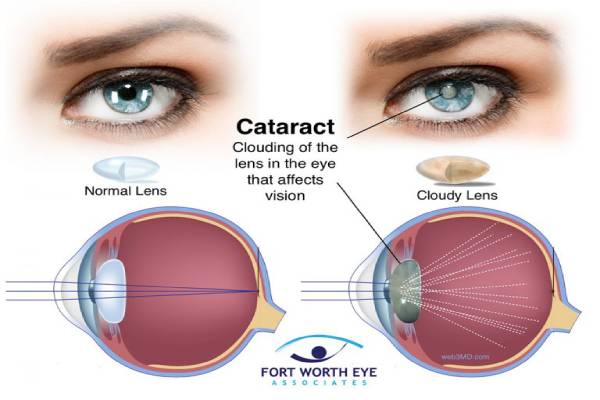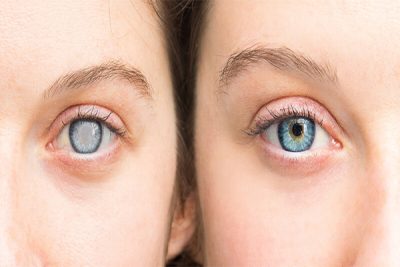ترجمه نوشته:

Cataract surgery
Modern treatment with advanced technology in Shiraz
Cataract is one of the most common eye diseases that causes the natural lens of the eye to become cloudy and gradually reduce vision. This disease may not have any visible symptoms at first, but over time, it will cause a decrease in the quality of a person’s vision. Cataract surgery is one of the most effective methods of treating this disease, which, with recent advances in technology, has become one of the most successful and least complicated eye treatments. In Iran, especially in Shiraz, the most advanced technologies and global methods are used to perform this surgery.
Steps of cataract surgery
Cataract surgery typically consists of several key steps:
Patient preparation: Before surgery, the patient undergoes detailed examinations, including eye measurements, corneal thickness, retinal condition, and other ocular parameters, to select the best treatment method.
Anesthesia: This surgery is usually performed under local anesthesia, so the patient is awake but will not feel any pain or discomfort.
Surgery: The surgeon uses advanced techniques such as phacoemulsification, in which the cloudy lens is broken up and removed from the eye with ultrasonic waves. An artificial lens is then placed inside the eye.
Rehabilitation and follow-up: After surgery, the patient should visit the doctor for follow-up and use antiseptic and anti-inflammatory drops to ensure a smooth recovery process.
Different methods of cataract surgery
Depending on each patient’s condition and technological advances, there are several methods for cataract surgery:
Phacoemulsification: This is the most common and precise surgical procedure that uses ultrasonic waves to break up and remove the cloudy lens.
Femtosecond laser: This method is one of the newest techniques that uses lasers to make incisions and remove the lens. This method is associated with high precision and reduced recovery time.
Laser Iris: In this method, a laser is used to correct the shape of the lens and make precise cuts in the eye.
Advantages and disadvantages of cataract surgery
Advantages:
High precision: Advanced methods such as phacoemulsification and femtosecond laser have greatly increased surgical precision.
Short recovery period: Most patients can return to their daily activities after a few hours or a few days at most.
Rapid vision improvement: Many patients see significant improvement in their vision immediately after surgery.
Disadvantages:
Rare complications: As with any surgery, in rare cases, complications such as infection, bleeding, or inflammation in the eye may occur.
Need for post-surgical care: The patient must take careful care of their eyes and avoid certain activities to achieve the best results.
The most suitable candidates for cataract surgery
Older people who have advanced cataracts.
Diabetic patients or people with other eye problems.
People who are unable to improve their vision by using glasses or contact lenses.
People who should not have cataract surgery
Patients suffering from active eye infections.
Those who have serious retinal problems.
Patients suffering from severe heart or respiratory problems.
Recovery period and post-surgical care
Rapid recovery period: Most patients feel significant improvement after a day or two and can return to their usual activities.
Post-surgical care: The patient should use antiseptic, anti-inflammatory, and antibiotic drops and avoid exposure to bright light or putting pressure on the eyes.
Why is Shiraz and Iran an ideal destination for cataract surgery?
With its expert doctors and the latest technology, Shiraz is one of the best destinations for cataract surgery in the world. The low cost of treatment in Iran compared to many Western countries, as well as the high quality of medical services, have made the city a popular destination for international patients.
Arvan Group Services: A Unique Experience of Treatment and Tourism
Arvan Group provides a unique experience of treatment in Shiraz by providing medical services and medical tourism to international patients. From the moment you arrive in Shiraz, our professional team will accompany you throughout the entire treatment process. Arvan Group services include airport transfers, accommodation in five-star hotels, and even tourism programs to Shiraz’s historical and natural attractions. After your surgery, you can visit the beautiful and historical places of Shiraz such as Persepolis, Eram Garden, Hafeziyeh, and Nasir al-Molk Mosque and experience relaxing moments alongside your treatment.
Conclusion
Cataract surgery in Iran, especially in Shiraz, using advanced technologies and under the supervision of expert doctors, is a very effective, affordable and safe option for cataract treatment. By choosing Arvan Group, you will not only benefit from high-quality treatment, but also from unparalleled tourism and welfare services in one of the most beautiful cities in Iran.
General information
About cataract eye surgery
Anesthesia:
Local anesthesia
Recovery period:
Three to four days
Duration of surgery:
Twenty to thirty minutes
Duration of hospitalization:
many hours
Return to normal life:
Seven to ten days
Cost:
-
Arvan treatment packages
Click to check Arvan packages

To book an appointment and receive a free consultation, contact us now.
Frequently Asked Questions About Cataract Surgery

Cataract surgery involves removing the cloudy lens and replacing it with a clear, artificial lens. The artificial lens, called an intraocular lens, is placed in the same place where your natural lens is located. The lens becomes a permanent part of your eye. Cataract surgery is generally done on an outpatient basis. This means that you will not need to stay in the hospital after the surgery. During cataract surgery, your eye doctor will use local anesthesia to numb the area around your eye, and you will be awake during the procedure. Cataract surgery is generally not risky, but there is a chance of infection and bleeding. Cataract surgery increases the risk of retinal detachment. You may feel sore for a few days after the surgery, and full recovery takes about eight weeks.
Currently, there are no nonsurgical treatments for cataracts that have been approved by the Food and Drug Administration or other medical regulators. In 2015, a paper was published reporting the discovery of a substance called compound 29. This water-soluble compound treated cataracts related to heredity and aging in the lens tissue. However, its use has limitations. Lanosterol, which is also being studied extensively as a potential solution for cataracts, is not water-soluble enough to be used as eye drops.
There is no natural cure for cataracts.
If you have cataracts, they will get worse over time and your vision will decrease. As your vision decreases, you will lose the ability to do everyday tasks, such as driving.
No, but there is a possibility of clouding of the lens of the eye, which can be treated with laser.
Articles related to cataract surgery
✅ Complete travel guide to Qalat Village, Shiraz | A mountain tourism gem with a waterfall, church, and eco-lodge
-
Posted by
arwan.ad
- 0 comments
“Journey to the heart of Azeri culture; treatment, relaxation, and a unique experience with Arvan Health Tourism Group”
-
Posted by
arwan.ad
- 0 comments
Advantages and disadvantages of tummy tuck😱
-
Posted by
arwan.ad
- 0 comments





